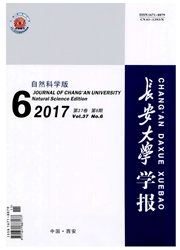

 中文摘要:
中文摘要:
随着列车轴重的不断增加,重载铁路路基的失稳破坏问题越来越突出,针对此现象,研究了神朔铁路路基填料在不同温度条件下的抗剪特性,采用北京交通大学冻土实验室自行研发的大型温控冻融界面直剪仪设计了一系列的直剪试验。该路基填料为低液限粉土,最优含水率取14.5%,压实系数取0.95,设置正温、-3℃、-5℃这3个温度等级,各选取4个不同的垂直压力进行试验。基于试验结果,详细分析了剪应力-剪切位移关系特征曲线、内摩擦角、黏聚力以及剪胀性等各项土体抗剪特性指标的变化及规律。研究结果表明:该路基填料的黏聚力受冷却温度的影响显著,在-3℃时的黏聚力比正温条件下大500kPa,比-5℃条件下小95.5kPa;随着冷却温度从正温降到-5℃,土体内摩擦角从19.6°增大到33.8°;不同温度及不同垂直压力条件下路基填料的剪应力-剪切位移关系曲线形态基本一致,均可分为压密、局部剪切和剪切破坏3个阶段;神朔铁路路基填料的抗剪强度受冷却温度的影响明显,冻结状态下抗剪强度较未冻结状态时的最大增幅达到400%以上,即便同为负温冻结状态,抗剪强度也会随冷却温度的降低而增大;路基填料在冻结状态下表现出明显的剪胀性,并且随着垂直压力的增大,剪胀性表现出明显的下降趋势,但是并没有随冷却温度的不同而产生明显的差异。
 英文摘要:
英文摘要:
With the increase of axle load,the instability failure of heavy haul railway subgrade is becoming more and more prominent.In order to obtain the shear strength of the subgrade filling of Shenshuo Railway at different temperatures,a series of direct shear tests were conducted by the large direct shear apparatus,which was developed in the Frozen Soil Laboratory of Beijing Jiaotong University.The subgrade filling is low liquid limit silt,the optimum moisture is 14.5%,which was selected as the moisture content of samples,and the compaction coefficient is 0.95.Three temperature levels of positive temperature,-3℃ and-5℃ were set up,and four different vertical pressures were selected to be tested.Based on the test results,the changes and regulations of various characteristics,such as shear stress-displacement,internal fiction angle,cohesion and shear dilatancy,were analyzed.The results show that the cohesion of subgrade filler is strongly influenced by the cooling temperature.Cohesion of subgrade filling at-3 ℃ is over 500 kPa than that at positive temperature,and is 95.5kPa less than that at-5 ℃.With the temperature decreasing from positive temperature to-5 ℃,the internal friction angle increases from 19.6° to 33.8°.Under the conditions of different temperatures and different vertical pressures,curves of shear stress-displacement are basically the same,which can be divided into consolidation stage,partial shear stage and failure stage.The shear strength of subgrade filling of Shenshuo Railway is significantly affected by cooling temperature.In frozen state,the maximum increase of shear strength is more than 400% compared with the unfrozen state.Even if they are all frozen at negative temperature,the shear strength also increases with the decrease of cooling temperature.The subgrade filling in frozen state shows obvious shear dilatancy.With the increase of vertical pressure,the shear dilatancy becomes decreasing.However,it has no obvious change with the cooling temperature.
 同期刊论文项目
同期刊论文项目
 同项目期刊论文
同项目期刊论文
 期刊信息
期刊信息
